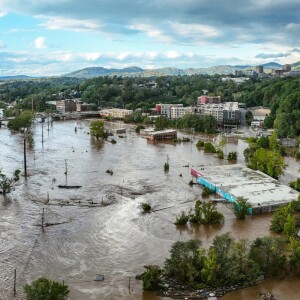Solutions for the Underaffiliated
Solutions for the Underaffiliated is a podcast for people who want hope and action because they are fed up with finger-pointing and incivility. We represent action, by providing examples of it. Its purpose is to inspire people through the examples our guests from the region, state, and country describe. We talk about potential solutions related to: climate change, economic opportunity, education, rights and justice, healthcare, and public safety. During each episode, we lay out the current state of a particular issue from the perspective of our guest. Then we lay out the challenges, usually through a review of the key stakeholder, e.g. government, industry, the media, special interests, and regular Americans. We identify what needs to change. Then we explore solutions that are either already underway by the group or guest as well as actions our audience could take to influence change and hold people accountable.
Episodes

Monday Oct 21, 2024
Monday Oct 21, 2024
Artists are building back their community that made Asheville a destination for the cool after the devastating flood.
The damage is unimaginable. So is the resilience. Learn what you can do.
Don't forget the gem that is Asheville.
Photo: Rolling Stone

Monday Oct 14, 2024
Monday Oct 14, 2024
Helene devastated Western North Carolina. Listen to what Todd James and Michael Tanner of the American Red Cross had to say about Helene's impact on Western North Carolina MEASURED IN YEARS, the importance of collaboration, and why local action is likely the key to success as these disasters become more common.
What's more? Be kind and remember: These climate events cause trauma.
Reuters Picture

Tuesday Sep 24, 2024
Tuesday Sep 24, 2024
Google and other global corporations have consolidated capabilities and services and manipulated regulations to capture all of our shopping and online behavior. They are monopolistic, so can control the information, products and services to which we have access. That means they manipulate us with messages to make us buy and think based on what political groups, companies and special interest groups pay them.
These conglomerates reduce your wages and benefits and use social media to make you accept it because what they sell looks so good. Your liberty fades -- your jobs pay less with fewer benefits. You depend on corporations that don't serve you. And you votre against your best interests.

Tuesday Aug 27, 2024
Tuesday Aug 27, 2024
-- Who gets a universal basic income? Oops! Maybe it's not universal.
-- The roots of the donkey and elephant as mascots
-- What is your United States? Hope or Revenge and Rage to make a nation better.
Photo by Marina Vitale on Unsplash

Tuesday Aug 20, 2024
Tuesday Aug 20, 2024
-- We seem to want to limit other people's speech even though we say it's foundational to democracy.
-- 9 actions to take to get out of your rut, and become more successful and happy.
-- Immigrants are still not taking anyone's job, but we need to pay them more so they spend money to boost the economy and not just make their employers rich.
Photo by Randy Fath on Unsplash

Thursday Aug 08, 2024
Thursday Aug 08, 2024
USA! USA! means cheers for the uber-diverse women's Olympic gold medal team and Donald Trump.
One nation, divided but we all want freedom and opportunity. What's the problem, how do we unify the United States?
Photo by Edgar Colomba: https://www.pexels.com/photo/human-hands-and-us-flag-2240293/

Wednesday Jul 31, 2024
Wednesday Jul 31, 2024
Misogyny begins at home and mons and dads help. Maybe it's time to reflect.
Ignorant defiance disorder is usually visible in adolescents. What if an entire nation is behaving like angry 15-year-olds with no accountability?
Vocations -- what teachers, social workers, nurses, fire fighters, journalists do -- you know, the people who care for our health, safety, and knowledge are underpaid and marginalized. We need to raise our voices and give them the praise and money they deserve.
https://ericjcarrig.podbean.com/e/the-parents-of-misogynists-americas-ignorant-defiance-disorder-bring-back-vocations/
Photo by Jon Tyson on Unsplash

Monday Jul 22, 2024
Monday Jul 22, 2024
Why are the left and right crushing the humanities when religious leaders wanted to use them to teach kids to be better citizens?
We spoke with Jeremy Philips, a humanities instructor, who explains why the humanities makes democracies stronger. Meanwhile the left and right crush lessons about being human with their agendas for individual rights and profit, which just lead to incivility. Not working.
Listen live at 11 AM, Mondays: www.ashevillefm.org and enjoy the tunes that fill the rest of our hour-long show -- or get the Asheville FM app.
Photo by Markus Winkler: https://www.pexels.com/photo/writings-on-the-wall-2893772/

Monday Jul 22, 2024
Monday Jul 22, 2024
The path to a collaborative government and civil society is to listen, speak our mind, and accept that we can disagree and still work together.
Braver Angels www.braverangels.org, teaches politicians and regular folks to listen and respond in productive ways to build back a society that isn't sucked into social and national media's hyper-inflammatory speech.
We spoke with three regional leaders, representing the left, right, and independents. They all got along. They are building a path for the health of humanity.

Friday Jun 14, 2024
Friday Jun 14, 2024
We need different leaders to solve immigration: Learn how both sides have valid points about immigration, but our just et us down.
Fun facts in a murky world: Origins of cold feet; What weather terms really mean; Ancient dating was worse than today.
Will only the rich get cops? As fewer cops get sworn in, private security is booming, which more people won't feel safe.
Photo by Mathieu Stern on Unsplash





